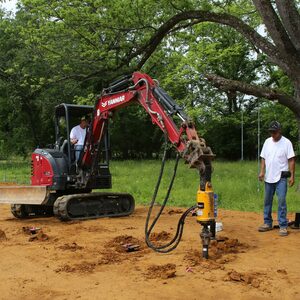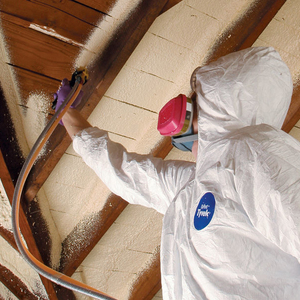No Housewrap needed if exterior rigid foam insulation being used?
Should Housewrap not be used when 1″ rigid (extruded polystyrene) insulation is being applied over plywood sheathing (then taped) then a rain-screen, and then Hardie board siding to complete the exterior of a house?
I was reading the latest FH magazine and the article on Flashing windows to foam sheathing recently. They are applying the rigid foam directly onto the studs with no sheathing, so that is a little different than we are applying, but they don’t use Housewrap in their application explanation.
I want to build this house correctly and not trap moisture. I have also read that perhaps vapour barrier should not be used on the interior of the stud wall so that the moisture might be able to dry to the inside. Does anyone know the best way?
What is the best way to treat walls when using rigid foam applied to the exterior in the interior of BC, Canada, where outside winter temperatures do drop to -20C fairly regularly, but are usually 0-minus5C?



















Replies
house wrap
I recently read that the tape used in this application is warranted for 10 years. I think that if sheathing/tape manufacturers are confident with their material, the warranty should be at least for 50 years. I at least don't want to be told that I should change my siding every 10 years. I would use the wrap as insurance. Thinking the worst case imagined, a failed tape can become a trough for the water.
The latest FHB has an article that says that a wall with outside foam must be allowed to dry to inside, therefore, no inside vapor barrier. Outside foam also should be thick enough as insulation to prevent inside condensation. Your foam cover should be thick enough to prevent condensation on the plywood surface. Refer to latest FHB for your zones and details. Hope it helps.
Rigid foam insulation application
Yes, I read the article in FH recently that referenced no interior vapour barrier to be used.....there are still a few gaps in my information though. Should rigid be glued to the sheathing using a PL 400 glue or a two part glue (I want the rigid to be applied evenly against the sheathing with no lumps of glue causing it to protrude)? Then when we attach the strips of wood to create a space (rain-screen application) before attaching the siding will this be nailed through the rigid into the sheathing and be strong enough to support the siding?
Probably sound like dumb questions to someone with lots of experience in this type of application, but I need to ask!
By the way....the suggestion to use housewrap as insurance is probably a smart one....thanks!
>>>Should rigid be glued to
>>>Should rigid be glued to the sheathing using a PL 400 glue
The PL people (LePage) make an adhesive specifically for foam board use. It's called PL 300.
The foam board also can be fixed to the wall with roofing nails/screws and big washers. I don't see any practical way to using glue to put up foam boards because at least you will have to wait for bottom layer to set. You may be thinking you should not put lot of nail holes into the foam boards, but nobody expects the boards to remain pristine in the course of construction.
Also, the boards do not have to lie perfectly flat on the sheathing. Their edges do not have to match up perfectly even. Unless you rip the walls apart, you may already have some curve in the wall (because of studs that are warped or such) and sheathing that may have loose nails or uneven edge. In fact this is good time to check the nails in the plywood and renail if some are loose. Don't just pound them back, put new nail next to them. Any mismatch up to 1/8-1/4" would be acceptable depending on how you are putting up the siding. The cleats for the air space or thick drainage mat will hide the mismatch by pressing the uneven edges back together with later nailing. If mismatch does not press together, you have underlying problem such as damaged sheathing or popped out nail. These should be repaired.
The foam can be nailed to anywhere in the sheathing but you have to mark where the studs are. Bottom most after the foundation is usually 2 layers of 2x sill plates, then 2x10 continuous length of wood called banding?(sorry but I keep forgetting the proper names of these), plywood deck and another 2x plate and then the studs begin. You need to figure out which nails are stud nails then hit them with a hammer. Solid feel and sound would mean the nails are firmly in the wood and not loose. A bouncy feel and hollow sound would mean that nail missed the wood or became loose. Again, use new nail in loose spots.
The verticle cleats, that actual siding nails into, must be nailed into the studs. This is where your strength is. Your nail should be long enough so that at least 1 " of nail is in the stud, not stud and plywood together.
Hope it helps and hope I wasn't beginning to write a book.
If it were my house in that climate I would use both VB and HW. Both involve inexpensive materials and minimal labour costs (relative to the overall construction cost). This puts you in control of interior humidity rather than leaving a potential problem for the future.
If you find interior humidity to be too low or high in the Winter it can be addressed with a humdifier or HRV.
I'm building my home with similar details, i.e. 1" rigid foam over stucco over wrinckled (stucco) house wrap over OSB. The house wrap isn't so much a wind barrier as a weather barrier and the wrinckled stuff acts as a secondary drainage plane behind the foam.
I have built two other structures with this method under steel siding. To date i have had no issues with either of them. the first is 10 years old and thesecond is entering its' fifth year.